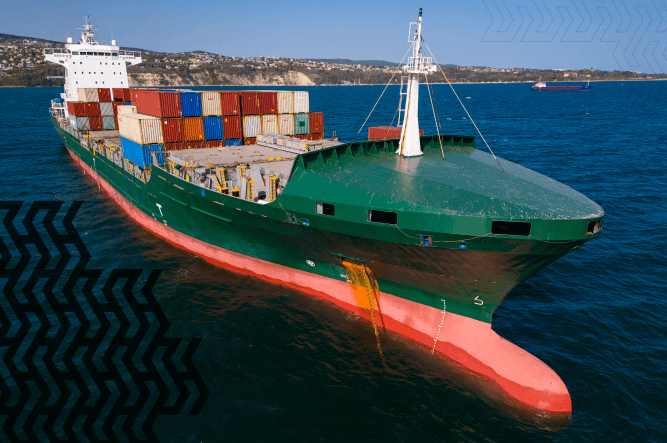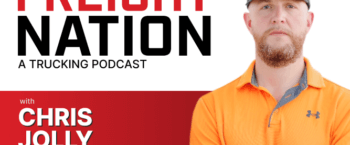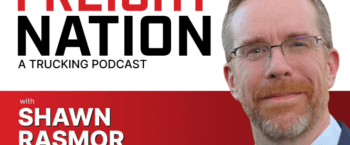The Francis Scott Key Bridge: Suspected Supply Chain and Economic Implications

Listen up!
Check out our podcast, Freight Nation, where industry experts talk all things trucking.
Contributed by Rob Carpenter, VP & Director of Managed Services at TruckSafe.
The maritime industry was rocked by chaos and uncertainty when the Francis Scott Key Bridge, a vital artery for trade in the Port of Baltimore, succumbed to a catastrophic collapse after being struck by the container ship “Dali,” chartered by Maersk. The ramifications of this event extend far beyond the physical damage inflicted on the bridge itself; they reverberate throughout the intricate web of global trade networks, affecting businesses, communities, and supply chains along the East Coast.
What Caused the Collapse?
“Dali” lost power twice and radioed a “Mayday” and a loss of power report before the bridge strike. Large ships find it challenging to change course when power loss occurs. Power loss is frequent but typically is short-lived. The NTSB is on it, but those reports have been known to take months and, in some cases, years.
Stranded Freight and Economic Disruption
1.1 million TEUs flowed through Baltimore Port in 2023. Compounding the challenges posed by the bridge collapse is the plight of countless merchants and exporters whose freight now languishes aboard vessels stranded in the Port of Baltimore. Having departed Virginia on March 22nd, the vessel in question carried a treasure trove of export freight from merchants in the Hampton Roads area of Virginia, North Carolina, Maryland, and beyond. With no immediate solution, significant financial losses loom, threatening livelihoods and economic stability.
The collapse of the Francis Scott Key Bridge and the subsequent closure of the Port of Baltimore have far-reaching implications for the domestic and global economy. As one of the primary gateways for international trade on the East Coast, the Port of Baltimore is pivotal in facilitating the movement of goods and commodities between the United States and the rest of the world. The disruption caused by the bridge collapse disrupts the flow of goods, causing ripple effects throughout the economy.
Impact on Supply Chain and Global Economy:
- Supply Chain Disruptions: The closure of the Port of Baltimore disrupts supply chains, leading to delays in the delivery of goods and components. Manufacturers, retailers, and businesses reliant on imported goods may experience shortages, production slowdowns, and increased costs as they need help to source alternative suppliers and transportation routes.
- Increased Costs: With supply chain disruptions and cargo rerouting to alternative ports, transportation costs are likely to surge. Higher shipping costs trickle down to consumers, raising prices for everyday goods and commodities. From electronics to clothing to food items, consumers may face inflationary pressures as businesses pass on higher transportation costs to maintain profit margins.
- Economic Impact: The financial fallout from the bridge collapse extends beyond the maritime industry, impacting various sectors of the economy. Reduced trade activity, disrupted supply chains, and increased business costs translate into lower productivity, decreased consumer spending, and slower economic growth. Small businesses, in particular, may need help to absorb the additional costs.
- Global Trade Flows: The disruption in trade flows from the Port of Baltimore reverberates across the global economy, affecting trading partners, suppliers, and customers worldwide. Countries reliant on exports to the United States may experience a slowdown in economic activity, while those dependent on imports from the U.S. may face supply shortages and increased costs.
Inflationary Pressures and Cost of Living
- Rising Prices: As transportation costs increase and supply chain disruptions persist, inflationary pressures mount. Higher prices for imported goods and supply shortages contribute to rising inflation rates, eroding consumers’ purchasing power and increasing the cost of living.
- Impact on Household Budgets: Inflation and higher prices for everyday goods strain household budgets, particularly for low and middle-income families. Increased expenses for groceries, fuel, and other essential items place additional financial burdens on already stretched budgets, leading to reduced discretionary spending and diminished quality of life.
- Wage-Price Spiral: Inflationary pressures may trigger a wage-price spiral, wherein workers demand higher wages to offset the rising cost of living. This, in turn, prompts businesses to raise prices further to cover increased labor costs, exacerbating inflationary trends and creating a cycle of economic instability.
Bridge Collapse Unravels Trade Routes
The Francis Scott Key Bridge served as a lifeline for the Port of Baltimore, facilitating the flow of goods and commerce to and from one of the busiest ports on the Eastern Seaboard. However, the bridge’s collapse has severed this crucial link, forcing maritime stakeholders to scramble for alternative routes and terminals to maintain trade flow. The bridge, known as Key Bridge, was a frequently used HAZMAT route, as HAZMAT carriers cannot use the Fort McHenry Tunnel or the Baltimore Harbor Tunnel.
Hazmat Rerouting and Logistics Nightmare
Adding to the logistical nightmare is the realization that the Francis Scott Key Bridge was the sole hazmat route for motor carriers traversing the Baltimore area. The bridge’s closure leaves hazmat shipments stranded and motor carriers grappling with the logistical headache of rerouting to the I-695 beltway further west. This exacerbates congestion and delays and raises concerns about safety and compliance with hazmat regulations.
Rescue and Recovery Amidst Tragedy
Amidst the chaos and devastation, resilience emerges as emergency responders launch a daring rescue and recovery mission to retrieve vehicles and their occupants submerged in the waters below the collapsed bridge. While the loss of life and property makes the fragility of infrastructure a focus, the swift and coordinated response offers some hope.
Exploring Alternative Trade Routes
As the maritime industry grapples with the fallout from the bridge collapse, attention turns to alternative trade routes and terminals along the East Coast. VIG in VA provides one of the deepest port channels on the East Coast as well as rail, barge, trucking, and container capabilities. Ports in New Jersey and New York also emerge as promising alternatives, offering proximity to major population centers and robust intermodal transportation networks conducive to efficient cargo handling and distribution. Likewise, terminals in Wilmington, North Carolina, and Charleston, South Carolina, present viable options for rerouting cargo previously destined for Baltimore.
As the dust and waves settle and the extent of the damage becomes clear, stakeholders must confront the harsh reality of rebuilding not just a bridge but also trust, confidence, and resilience in the maritime industry. The maritime sector has faced a laundry list of failures in recent years that have stalled economic progress and increased inflation.
Our infrastructure’s fragility and global trade’s interconnectedness have become apparent.
Magnifying the Need for Preventative Measures and Safety Protocols
The Francis Scott Key Bridge collapse emphasizes the importance of safety protocols and risk mitigation strategies across all modes of transportation. Incidents like this underscore the need for proactive measures to prevent catastrophic events and ensure passengers, crew members, and cargo safety and security.
Unified Approach to Safety
While each mode of transportation—motor carriers, airlines, trains, or ships—operates within its own regulatory framework, there are similarities in safety, regulatory compliance, and risk mitigation protocols. From surface security measures to pilot, captain, and truck driver qualifications, a unified approach to safety ensures consistency and effectiveness in safeguarding transportation infrastructure.
Surface Security Protocols
Surface security protocols are key to enhancing the resilience of transportation networks against external threats such as hijackings and ramming attacks. Whether at sea, on the road, or on the rails, comprehensive situational awareness and adherence to security protocols are paramount. Training programs must equip personnel with the skills and knowledge to recognize and respond effectively to potential security threats.
Mitigating Electrical and Power Failures
Electrical failures and power outages threaten the safety and operation of all modes of transportation. From ships losing power at sea to trains experiencing electrical malfunctions, the consequences of such failures can be deadly. Rigorous maintenance programs, adherence to industry standards, and proactive risk management are essential to mitigating the risks associated with electrical and power failures.
Qualification and Training Programs
The qualifications and training of pilots, captains, and truck drivers are crucial to ensuring the safe and efficient operation of transportation systems. Rigorous certification processes, ongoing training programs, and adherence to regulations are vital to maintaining high standards of professionalism and competence across all modes of transportation.
Addressing Fatigue and Distraction
Fatigue and distraction pose risks across all modes of transportation, from boat captains navigating waters to truck drivers on the highway. Implementing fatigue management programs, conducting regular drug testing, and promoting a culture of safety and accountability are essential in mitigating these risks and ensuring the well-being of transportation personnel.
Proactive Risk Management
A proactive approach to risk management, predictive maintenance, and continuous improvement is crucial to prevention, regardless of industry or mode of transport. By leveraging data analytics, predictive modeling, and emerging technologies, transportation operators can identify and address potential risks before they escalate into crisis and chaos.
** Please note, details and accounts of this event may change rapidly. This article is based on information available at the time of publication.

Rob is an experienced regulatory compliance, DOT, safety, security, OSHA, Fire and Life Compliance Executive with decades of experience in safety management within the motor carrier industry. Rob has been a commercial driver, a safety director at a large passenger carrier, and has even owned his own trucking & brokerage companies.
Topics:

Find out how our platform gives you the visibility you need to get more done.
Get helpful content delivered to your inbox.
Schedule a demo.
Find out how our platform gives you the visibility you need to get more done.





